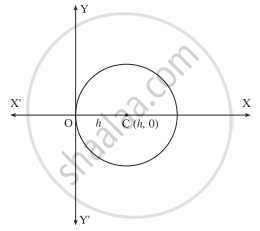Advertisements
Advertisements
Question
Form the differential equation of all circles which pass through the origin and whose centers lie on X-axis.
Solution

Let C(h, 0) be the center of the circle which passes through the origin. Then the radius of the circle is h.
∴ equation of the circle is (x - h)2 + (y - 0)2 = h2
∴ x2 - 2hx + h + y2 = h2
∴ x2 + h2 = 2hx ....(1)
Differentiating both sides w.r.t. x, we get
`"2x" + "2y" "dy"/"dx" = "2h"`
Substituting the value of 2h in equation (1), we get
`"x"^2 + "y"^2 = ("2x" + "2y" "dy"/"dx")"x"`
∴ `"x"^2 + "y"^2 = 2"x"^2 + 2"xy" "dy"/"dx"`
∴ `"2xy" "dy"/"dx" + "x"^2 - "y"^2 = 0`
This is the required D.E.
APPEARS IN
RELATED QUESTIONS
Find the the differential equation for all the straight lines, which are at a unit distance from the origin.
For the differential equation, find the general solution:
`dy/dx + 2y = sin x`
For the differential equation, find the general solution:
`dy/dx + y/x = x^2`
For the differential equation, find the general solution:
`x log x dy/dx + y= 2/x log x`
For the differential equation, find the general solution:
`x dy/dx + y - x + xy cot x = 0(x != 0)`
For the differential equation, find the general solution:
`(x + 3y^2) dy/dx = y(y > 0)`
For the differential equation given, find a particular solution satisfying the given condition:
`(1 + x^2)dy/dx + 2xy = 1/(1 + x^2); y = 0` when x = 1
Find the equation of a curve passing through the point (0, 2) given that the sum of the coordinates of any point on the curve exceeds the magnitude of the slope of the tangent to the curve at that point by 5.
Find the general solution of the differential equation `dy/dx - y = sin x`
Solve the differential equation `x dy/dx + y = x cos x + sin x`, given that y = 1 when `x = pi/2`
\[\frac{dy}{dx}\] = y tan x − 2 sin x
Find the general solution of the differential equation \[x\frac{dy}{dx} + 2y = x^2\]
Find the general solution of the differential equation \[\frac{dy}{dx} - y = \cos x\]
Solve the differential equation \[\left( y + 3 x^2 \right)\frac{dx}{dy} = x\]
Solve the following differential equation:-
\[\left( 1 + x^2 \right)\frac{dy}{dx} - 2xy = \left( x^2 + 2 \right)\left( x^2 + 1 \right)\]
Solve the following differential equation:
`"dy"/"dx" + "y"/"x" = "x"^3 - 3`
Solve the following differential equation:
`cos^2 "x" * "dy"/"dx" + "y" = tan "x"`
Solve the following differential equation:
`(1 - "x"^2) "dy"/"dx" + "2xy" = "x"(1 - "x"^2)^(1/2)`
Solve the following differential equation:
`(1 + "x"^2) "dy"/"dx" + "y" = "e"^(tan^-1 "x")`
Find the general solution of the equation `("d"y)/("d"x) - y` = 2x.
Solution: The equation `("d"y)/("d"x) - y` = 2x
is of the form `("d"y)/("d"x) + "P"y` = Q
where P = `square` and Q = `square`
∴ I.F. = `"e"^(int-"d"x)` = e–x
∴ the solution of the linear differential equation is
ye–x = `int 2x*"e"^-x "d"x + "c"`
∴ ye–x = `2int x*"e"^-x "d"x + "c"`
= `2{x int"e"^-x "d"x - int square "d"x* "d"/("d"x) square"d"x} + "c"`
= `2{x ("e"^-x)/(-1) - int ("e"^-x)/(-1)*1"d"x} + "c"`
∴ ye–x = `-2x*"e"^-x + 2int"e"^-x "d"x + "c"`
∴ e–xy = `-2x*"e"^-x+ 2 square + "c"`
∴ `y + square + square` = cex is the required general solution of the given differential equation
The integrating factor of the differential equation sin y `("dy"/"dx")` = cos y(1 - x cos y) is ______.
Integrating factor of `dy/dx + y = x^2 + 5` is ______
Integrating factor of the differential equation `(1 - x^2) ("d"y)/("d"x) - xy` = 1 is ______.
State whether the following statement is true or false.
The integrating factor of the differential equation `(dy)/(dx) + y/x` = x3 is – x.
Let y = y(x), x > 1, be the solution of the differential equation `(x - 1)(dy)/(dx) + 2xy = 1/(x - 1)`, with y(2) = `(1 + e^4)/(2e^4)`. If y(3) = `(e^α + 1)/(βe^α)`, then the value of α + β is equal to ______.
If y = y(x) is the solution of the differential equation, `(dy)/(dx) + 2ytanx = sinx, y(π/3)` = 0, then the maximum value of the function y (x) over R is equal to ______.
If the solution curve y = y(x) of the differential equation y2dx + (x2 – xy + y2)dy = 0, which passes through the point (1, 1) and intersects the line y = `sqrt(3) x` at the point `(α, sqrt(3) α)`, then value of `log_e (sqrt(3)α)` is equal to ______.
If the slope of the tangent at (x, y) to a curve passing through `(1, π/4)` is given by `y/x - cos^2(y/x)`, then the equation of the curve is ______.
If sin x is the integrating factor (IF) of the linear differential equation `dy/dx + Py` = Q then P is ______.
The solution of the differential equation `dx/dt = (xlogx)/t` is ______.
Solve the differential equation `dy/dx+2xy=x` by completing the following activity.
Solution: `dy/dx+2xy=x` ...(1)
This is the linear differential equation of the form `dy/dx +Py =Q,"where"`
`P=square` and Q = x
∴ `I.F. = e^(intPdx)=square`
The solution of (1) is given by
`y.(I.F.)=intQ(I.F.)dx+c=intsquare dx+c`
∴ `ye^(x^2) = square`
This is the general solution.
If sec x + tan x is the integrating factor of `dy/dx + Py` = Q, then value of P is ______.
